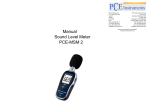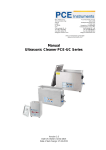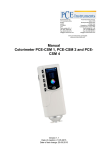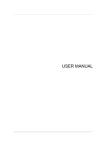Download manual vibration meter pce-vt2700
Transcript
PCE Americas Inc. 711 Commerce Way Suite 8 Jupiter FL-33458 USA From outside US: +1 Tel: (561) 320-9162 Fax: (561) 320-9176 [email protected] PCE Instruments UK Ltd. Units 12/13 Southpoint Business Park Ensign way Hampshire / Southampton United Kingdom, SO31 4RF From outside UK: +44 Tel: (0) 2380 98703 0 Fax: (0) 2380 98703 9 [email protected] www.pce-instruments.com/english www.pce-instruments.com Manual Vibration Meter PCE-VT2700 Version 2.0 Date of creation: 17.03.2015 Date of last change: 22.04.2015 Manual Contents 1 Introduction ............................................................................................................. 3 2 Safety notes ............................................................................................................. 3 3 Specifications .......................................................................................................... 3 4 System description ................................................................................................. 4 5 Measuring functions (parameters) ........................................................................ 5 5.1 Acceleration ................................................................................................................................ 5 5.2 Velocity ....................................................................................................................................... 5 5.3 Displacement .............................................................................................................................. 5 6 Instructions.............................................................................................................. 6 6.1 Measurement .............................................................................................................................. 6 6.2 Battery replacement ................................................................................................................... 6 7 Further information on vibration measurement ................................................... 6 8 Disposal ................................................................................................................... 7 9 Contact ..................................................................................................................... 7 9.1 PCE Instruments UK .................................................................................................................. 7 9.2 PCE Americas ............................................................................................................................ 7 2 Manual 1 Introduction Thank you for purchasing a vibration meter PCE-VT2700 from PCE Instruments. This vibration meter is perfectly suitable for maintenance as it tests vibrating parts, machines and equipment easily and quickly. With the PCE-VT2700, you can measure acceleration (m/s²), displacement (mm), frequency (Hz, F) as well as velocity (RPM). This means that you can detect and trace imbalance easily and reliably and avoid bearing damage by localising the source of undesirable vibration. By means of an integrated RS-232 interface, you can transfer data directly from the meter to a PC. In addition to the device, the delivery includes two measuring tips, a sensor, a magnetic plate, a carrying case and this manual. An ISO calibration certificate is optionally available. 2 Safety notes Please read this manual carefully and completely before you use the device for the first time. The device may only be used by qualified personnel and repaired by PCE Instruments personnel. There is no warranty of damages or injuries caused by non-observance of the manual. - The device may only be used in the approved temperature range. - The case should only be opened by qualified personnel of PCE Instruments. - The instrument should never be placed with the user interface facing an object (e.g. keyboard side on a table). - You should not make any technical changes to the device. - The appliance should only be cleaned with a damp cloth / use only pH-neutral cleaner. This manual is published by PCE Instruments without any guarantee. We expressly point to our general guarantee terms which can be found in our general terms of business. If you have any questions please contact PCE Instruments. 3 Specifications Measurement range Resolution Accuracy Frequency range Display Interface Battery Operating conditions Dimensions Weight acceleration 0.1 … 400.0 m/s² (Peak) velocity 0.1 … 400.0 mm/s (RMS) displacement 0.001 … 4.000 mm (P-P) revolutions 5 … 100.000 rpm 0.1 m/s²; 0.1 mm/s; 1 µm, 1 rpm ± 5% acceleration 10 Hz … 10 kHz velocity 10 Hz … 1 kHz displacement 10 Hz … 1 kHz 4-digit LC display, value last measured is displayed RS-232 4 x 1.5 V AAA batteries battery life up to 4.5 hours at continuous operation 0 … 50 °C, < 90% RH 124 x 62 x 30 mm 240 g 3 Manual 4 System description 1) Sensor connection 2) Display 3) METRIC / IMPERIAL key (units) 4) HOLD key 5) Volume key 6) Earphone connection 7) Connection for RS-232 cable 8) FUNCTION key 9) FILTER key 10) On / off key 11) Battery compartment cover 12) Sensor 4 Manual 5 Measuring functions (parameters) 5.1 Acceleration Acceleration is measured in m/s² (F/s²). Acceleration measurement is particularly useful for the localisation of high-frequency vibration and is therefore suitable for the determination of faults in bearings and gearboxes. By means of the FILTER key, you can set the frequency. Display: 1 kHz (10 Hz … 1 kHz) 10 kHz (10 Hz … 10 kHz) 5.2 Velocity Velocity is the parameter most frequently used and is applied to vibration measurement in line with ISO 2372, BS 4675 and VDI 2056 ISO 10816. Velocity is measured in mm/s (inch/s). Base Description Group Vibration velocity mm/s RMS 10 – 1000 Hz n ˃800 min -1 (1– 1000 Hz n ˃120 min -1) Machine vibration (DIN ISO 10816) 11.00 … ∞ 7.10 … 11 4.50 … 7.10 3.50 … 4.50 2.80 … 3.50 2.30 … 2.80 1.40 … 2.30 0.0 … 1.40 hard stretch pumps ˃ 15 kW hard stretch pumps ˃15 kW multiblade rotor with direct drive multiblade rotor with separate drive 4 3 hard stretch medium-sized machines 15 kW ˂P˂300 kW motors 160 mm ˂H˂315 mm (≈6.30" ˂H˂12.40") 2 hard stretch big machines 300 kW ˂P˂50 MW motors 315 mm ˂H (≈12.40" ˂H) 1 Explanations: Class 1 – big machines (P: 300 kW … 50 MW), electrical machines with an axle height h of ≥315 mm Class 2 – medium-sized machines (P: 15 kW … 300 kW), electrical machines with an axle height h of 160 … 315 mm Class 3 – pumps with multiblade rotors and separate drive P ˃15 kW Class 4 – pumps with multiblade rotors and und direct drive P ˃ 15 kW A – vibration good B – vibration ok C – vibration not ok D – vibration prohibited Vibration velocity measurements should be made in three axis directions (X, Y and Z axis), vertical to the surface of the machine housing. 5.3 Displacement Due to its good low-frequency response, this parameter is generally used for low-speed machines. The unit of measurement for this parameter is mm. 5 Manual 6 Instructions 6.1 Measurement Connect the sensor you have chosen to the device. Switch on the device by means of the Power key and place the sensor at the object to be measured. For even surfaces, the magnet included in the delivery content is very suitable. By means of the function key “FUNC.”, you can select the measurement function which is either acceleration measurement (m/s²), velocity measurement (mm/s), displacement measurement (mm), frequency measurement (Hz F) or revolutions measurement (rpm). To make a selection, press the “FUNC.” Key several times until the desired measurement function is displayed. By pressing the “HOLD” button, you can hold the maximum value of your measurement. “MAX” will appear in the upper area of the display. You can deactivate this function by pressing “HOLD” again. The “METRIC / IMPERIAL” key is used to set the units. For acceleration measurement, the units m/s² and F/s² are available, for velocity measurement, you can select inch/s or mm/s and for displacement measurement, the units mm and mil can be selected. When you work with headphones, you can control the volume (1 … 8) by pressing the “VOL” key several times until the desired value is indicated in the display. If machines or bearings are operated under the same circumstances, you can use this device to carry out reference measurements. By analysing these data, irregularities of the individual machines can be detected to recognise possible faults at an early stage. Make sure that these measurements are always carried out at the same spots in order to achieve high accuracy. 6.2 Battery replacement Switch off the device and remove the battery compartment cover. Remove the batteries and insert some new ones (4 x 1.5 AAA batteries). Close the battery compartment cover. 7 Further information on vibration measurement Vibration measurement provides reliable information that allows conclusions regarding the mechanical condition of a machine or product. Ideally, a machine has very little or no vibration as this indicates that the motor as well as the peripheral devices such as gears, fans, compressors and other devices are sufficiently balanced and aligned and correctly installed. In practice, a high percentage of installations are far from ideal which is due to incorrect alignment and balancing and results in higher strain on loadbearing parts like bearings. This causes high strain on and wear of important parts and thus inefficiency, heat generation and production downtime. Of course, this normally happens at the most inconvenient and economically most inappropriate time and causes expensive production losses. Vibration increases as wear and deterioration of mechanical parts rises. By regularly controlling the vibration of faultless mechanical parts, you can detect deteriorations before they cause problems. This means that you are in a position to order replacement parts in time and maintenance work must only be carried out when required. This is to avoid expensive and unnecessary stocks of replacement parts, which brings financial advantages. Unanticipated interruptions cause production downtime. Defective machines and equipment are often repaired in a hurry so that production can be continued as soon as possible. Regardless of how precisely the staff works, it is not always possible under these circumstances to carry out repairs correctly. This can in turn lead to machine and equipment downtime again. A predictive maintenance schedule according to which important factors like vibration are measured on a regular basis does not only allow you to reduce interruptions in production but also to make maintenance work more effective. This increases product quality and productivity. The term “trend” is very important to know in connection with vibration measurement. A trend indicates how a monitored parameter behaves over time. If vibration measurements have been made and plotted over a certain period of time, the resulting graph shows the progress or the deterioration of a certain machine. Immediately after installation, it is possible that the vibration level decreases slightly as the machine is run in, no matter if the machine is new or was repaired. This period is followed by the normal operating time of the machine, which is a longer period of time during which the vibration level does not change. The next period will be one during which the vibration level will increase due to wear of machine components before the machine eventually stops working. Such a trend enables the engineer to predict the approximate downtime, to maximise the benefit of the machine, to order replacement parts and at the same time to adapt maintenance work to the production schedule. 6 Manual 8 Disposal For the disposal of batteries, the 2006/66/EC directive of the European Parliament applies. Due to the contained pollutants, batteries must not be disposed of as household waste. They must be given to collection points designed for that purpose. In order to comply with the EU directive 2012/19/EU we take our devices back. We either re-use them or give them to a recycling company which disposes of the devices in line with law. If you have any questions, please contact PCE Instruments. 9 Contact If you have any questions about our range of products or measuring instruments please contact PCE Instruments. 9.1 PCE Instruments UK By post: PCE Instruments UK Ltd. Units 12/13 Southpoint Business Park Ensign Way, Southampton Hampshire United Kingdom, SO31 4RF By phone: 02380 987 035 9.2 PCE Americas By post: PCE Americas Inc. 711 Commerce Way Suite 8 Jupiter 33458 FL USA By phone: 561 320 9162 7













